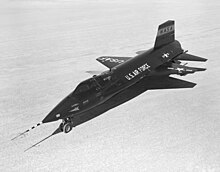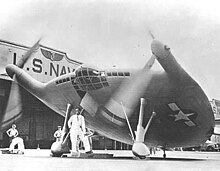Experimental airplane

The term experimental aircraft is used in aviation for a wide range of special aircraft intended for technical and scientific experiments . Both the type and the aim of the tests that are carried out with these aircraft and the development or retrofitting of aircraft that are used as experimental aircraft can be very different. The terms experimental aircraft or research aircraft are often used synonymously . What all experimental aircraft have in common is that they are either one-offs or that they are only produced or converted in a small series of a few copies.




operator
The internationally best-known institutions that regularly operate test aircraft are NASA in the USA and the Royal Aircraft Establishment in Great Britain . In the USA, however, test facilities are also operated by the individual branches of arms. For the US Air Force this is the US Air Force Operational Test And Evaluation Center and for the US Navy it is the Naval Air Station Patuxent River ("NAVAIR").
In Germany, the aerospace center is the operator of a larger fleet of research aircraft in the civil sector . But the Federal Ministry of Education and Research (BMBF) also bears the majority of the costs in individual projects (see HALO ). In the military field, similar tasks in the field of equipment, information technology and use (AIN) have been taken over by the Wehrtechnischen Dienststelle 61 since 1957 . Before and during the Second World War, the Rechlin test center was the operator of test samples.
use
The following categorization of the use of test aircraft is based on a classification based on the typical possible uses and a common operational background. However, no recognized classification in this form is known from the literature, although there can of course be smooth transitions between the individual categories.
Research aircraft - basic research
In the field of applied research, aircraft are used that are conceptually only intended as test aircraft. Basic solutions for technical-scientific questions in the field of aerodynamics, engine construction and the basic design of aircraft are sought. Research activities in connection with the technical feasibility of physical effects that are considered to be useful in aircraft construction can also be classified under this point.
The constructions that arose in the early days of aviation can generally be referred to in the broader sense as research aircraft, as little was known about the physical principles of aerodynamics and the structural requirements for a safe aircraft. Every newly built aircraft differed, at least in details, from its predecessor, as the previous knowledge was taken into account.
One of the first test aircraft with a research purpose in the narrower sense was certainly the Junkers J1 , which flew for the first time in 1915. The aim of the investigation was the fundamental testing of new design principles. These included:
- Cantilever all-metal construction
- New construction similar to a monocoque , with a partial absorption of forces by the aircraft skin.
This category includes the majority of US aircraft that were operated by NASA and the USAF and were designated within the "X" series.
Further examples:
- Junkers Ju 49 - high-altitude research aircraft of the German Aviation Research Institute (DVL)
- He 176 - Testing of new types of propulsion ( rocket propulsion )
- He 178 - Testing of new types of propulsion ( jet propulsion )
- Avro 707 - Properties of a new type of wing layout on a small scale
- NASA AD-1 - Feasibility of Unconventional Layouts ( Oblique Wing )
- Antares DLR-H2 - fuel cells as APU in commercial aircraft
Mission-oriented research aircraft
Airplanes that are intended to show the practical feasibility of the solutions found in the basic studies for a specific purpose. This also includes the optimization of the solutions found basically feasible for a given role.
The first test aircraft in this category was perhaps the Junkers J2, built in 1916 . The basic findings on all-metal construction that were gained with the Junkers J1 should be implemented in a fighter aircraft.
Further examples:
- Lockheed XFV-1 , Convair XFY-1 - Suitability of VTOL aircraft for role as a military fighter aircraft
- Do 31 , XC-142 - Suitability of VTOL aircraft as civil and military transporters
- X-35 - Use of a simple S / VTOL technology for a high-performance fighter aircraft
- XB-35 , XB-49 - Suitability of the flying wing design for use as a bomber
- XP-55 - Suitability of the flying wing design for use as a fighter aircraft
Prototypes as test aircraft
Airplanes that were originally planned as prototypes for series production sometimes remain individual copies. This can e.g. B. be caused by the fact that the requirements for the commissioned aircraft have changed at short notice. However, it is just as possible that the use of insufficiently tested technologies can result in unforeseeable difficulties that prevent series production. The copies already produced are used in individual cases to test new technologies, v. a. then if the reason for the discontinuation of series production was due to untested technical implementations.
Examples:
- Short Sperrin - engine testing
- XB-70 - Feasibility of a Mach 3 bomber plane
Even prototypes that were not sold by the manufacturer can be used as test aircraft. A well-known example of this is the Boeing 367-80 "Dash-80", which first served as a prototype for the KC-135 and Boeing 707 , but was then used for many years as an aircraft for various test programs.

Converted series aircraft as test vehicles
From an ongoing or already completed series production, individual copies are converted into test carriers for unproven devices, engines, etc.
Examples:
- Focke-Wulf Fw 58 - Investigations on boundary layer suction
- Boeing NB-52 - carrier aircraft for various non-self-launching aircraft
- Avro Vulcan - Flying test stand for the Concorde engine
Other research aircraft
This includes all aircraft that are used for research topics outside of aircraft-related technology. These are predominantly airplanes that serve as carriers for experiments that can only be carried out airborne.
Examples:
- Collection of meteorological data
- Atmospheric research, (e.g. High Altitude and Long Range Research Aircraft )
- Carrier for astronomical telescopes (e.g. Stratospheric Observatory For Infrared Astronomy )
- Typhoon forecast
- Collecting Air Samples (NASA CV-990)
In Germany, the term “research aircraft” is used almost exclusively for this category of test aircraft. In the USA, however, “Research Aircraft” also stands for the use of aircraft in the field of fundamentally new concepts. The reason for this different use of the term may be that in Germany there is almost no fundamental research in the field of new aircraft concepts. This was different in the 1950s when v. a. Extensive basic research has been carried out on the technology of vertical take-off aircraft in Germany.
Occasionally, aircraft that are used to provide logistical support for research activities / expeditions are also referred to as research aircraft, although they are completely normal production aircraft.
"X" in the aircraft designation
There is some confusion about the meaning of the prefix "X" in aircraft names used by the American armed forces.
Since 1948, the USAF uses the letter "X" marking of the main intended use research (Research) in aircraft. All aircraft in this series of names can therefore generally be viewed as test aircraft. In addition to the USAF, NASA also uses this series of names. These aircraft are mostly one-offs, but are also built in small series (e.g. six X-1 copies, three X-15 copies, two X-22 copies ).
In contrast, the "X" addition in the type designation as a designation for the experimental status of an aircraft is not synonymous with a declaration of the type as an experimental aircraft. This status code should only be used during the development and test phase. If the sample was not produced in series, the existing material was of course often used for research purposes (e.g. XB-70). This addition to the designation has not been used since 1962.
The last assigned numbers with an X-prefix were:
- For F-Series: XF-104 Starfighter (1952)
- For B-series: XB-70 Valkyrie (1962)
- For C-series: XC-142 (1962)
As a transition between prototype status and series production, the pre-series status abbreviation "Y" was sometimes used until 1962. In the meantime, “Y” is officially the status code for a prototype, as the better technical calculation and planning options mean that no prototypes in the true sense of the word have to be produced for fundamental testing of the design.
Aircraft built by amateurs themselves (so-called homebuilts ) fly in the USA with an "Experimental Category Airworthiness Certificate" and are marked with the label Experimental , but they must not be confused with test aircraft (see also experimental approval ).
Selection of current test centers
The list summarizes a selection of current flight test sites and their operators.
- Eglin Air Force Base , Nellis AFB - US Air Force Operational Test And Evaluation Center (AFOTEC)
- Edwards Air Force Base, California - NASA ( Dryden Flight Research Center )
- Naval Air Station Patuxent River - Testing of all US Navy related aircraft
- Farnborough, Hampshire - Defense Science and Technology Laboratory (former Royal Aircraft Establishment ) British aircraft testing facility
- Manching - Wehrtechnische Dienststelle 61 of the Equipment, Information Technology and Utilization Division (AIN)
- Zhukovsky (Ramenskoye) - Russian Test Center ( Central Aerohydrodynamic Institute , Mikhail Gromov University of Flight Research )
- Istres-Le Tubé, Cazaux and Toulouse-Francazal (the latter closed in 2010) - DGA Essais en vol (formerly: Center d'essais en vol, CEV)
See also
Web links
Individual evidence
- ^ Air Force Operational Test and Evaluation Center website
- ↑ Air Force Operational Test and Evaluation Center factsheet ( Memento from August 1, 2013 in the Internet Archive )
- ↑ Air Force Historical Research Agency: Direct Reporting Units ( Memento of the original from April 8, 2011 in the Internet Archive ) Info: The archive link was automatically inserted and not yet checked. Please check the original and archive link according to the instructions and then remove this notice.
- ↑ Naval Air Systems Command ( Memento from October 16, 2015 in the Internet Archive )
- ↑ Suitability of fuel cells as APU
- ↑ Archived copy ( memento of the original from July 20, 2009 in the Internet Archive ) Info: The archive link was inserted automatically and has not yet been checked. Please check the original and archive link according to the instructions and then remove this notice. Meteorological data with the Do 128
- ↑ High Altitude and Long Range Research Aircraft ( page no longer available , search in web archives ) Info: The link was automatically marked as defective. Please check the link according to the instructions and then remove this notice.
- ↑ Russian Geophysica
- ↑ Characteristics of the SOFIA project at dlr.de
- ↑ Typhoon forecast
- ↑
- ↑ AFOTEC homepage
- ↑ Information on Zhukovsky test facilities